
Boshof
A little town in the West of the Free State, about 130 km from Bloemfontein geo-position: 28.54°S, 25.239°E, 1257m above sea level.
Founded in 1856, it is one of the early towns established in the Free State. That a town should be established here goes back to the initiative of Andrew Murray, one of the early preachers in the NG church in the Free State. The farm, the town was laid out on, is van Wyksvlei. The Koronachief David Dauster originally owned it. He sold it and his other two farms, Kameelfontein and Tweefontein, in July 1839 to David Stefan Fourie and his two sons-in-law, in exchange for a riding horse and 16 sheep.
The new town was named after the president of the Free State at the time, J.N.Boshof, he was president from 1854 to 1859. In 1872 it became a municipality.
NG church
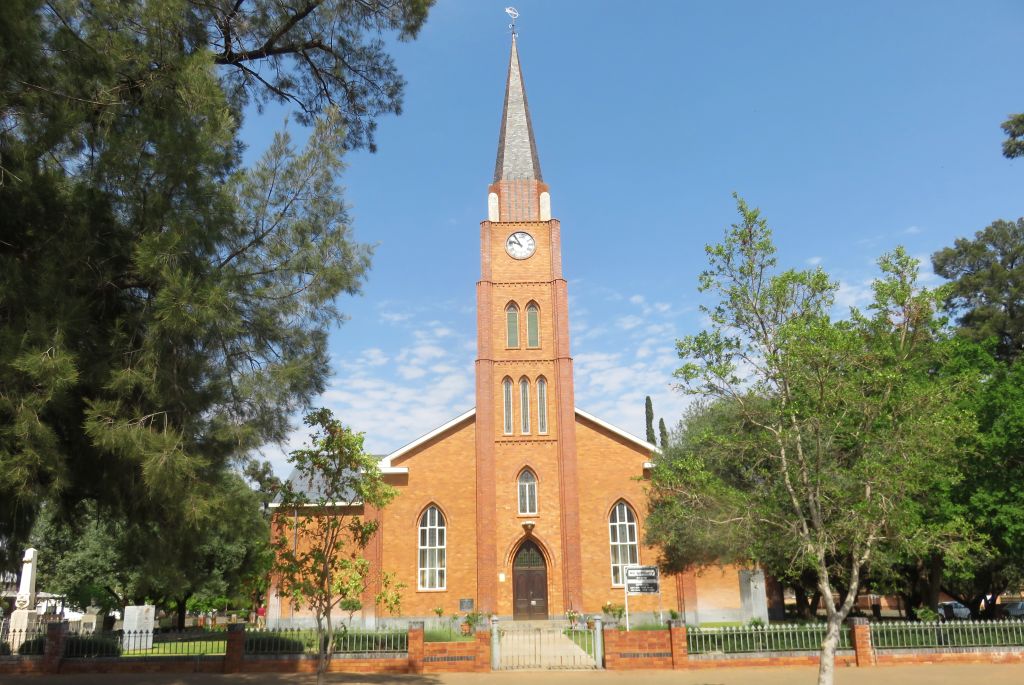
 The town exists because of the church. After the first farmers moved to the area in 1839 more followed and by 1855 there were enough to form a congregation.
The town exists because of the church. After the first farmers moved to the area in 1839 more followed and by 1855 there were enough to form a congregation.
The first church building was constructed on the market square by mostly the deacons and the elders of the congregation. It was a plain building of clay with a thatched roof and no seating. Worshippers had to bring their own chairs.
Building the new church started in 1871 and was completed in 1874, the architect was Richard Wocke (1831-1890), a builder and architect who came from Germany and was the first architect to settle in Bloemfontein. Initially the church was laid out for 1000 seats, later it was expanded to add another 100 seats, 1913.
Memorials
 There are several monuments in the churchyard. A memorial to remember the burghers who lost their lives during the Anglo-Boer war 1899-1902.
A bust nearby is that of General Gideon F.Joubert (1823-1907). I cannot find anything else about him, except from what is written on the memorial. He was Kommandant General for the central and north-western parts of the Free State during the Basutu wars of 1861 to 1868. And later a member of the Volksraad (parliament).
There are several monuments in the churchyard. A memorial to remember the burghers who lost their lives during the Anglo-Boer war 1899-1902.
A bust nearby is that of General Gideon F.Joubert (1823-1907). I cannot find anything else about him, except from what is written on the memorial. He was Kommandant General for the central and north-western parts of the Free State during the Basutu wars of 1861 to 1868. And later a member of the Volksraad (parliament).
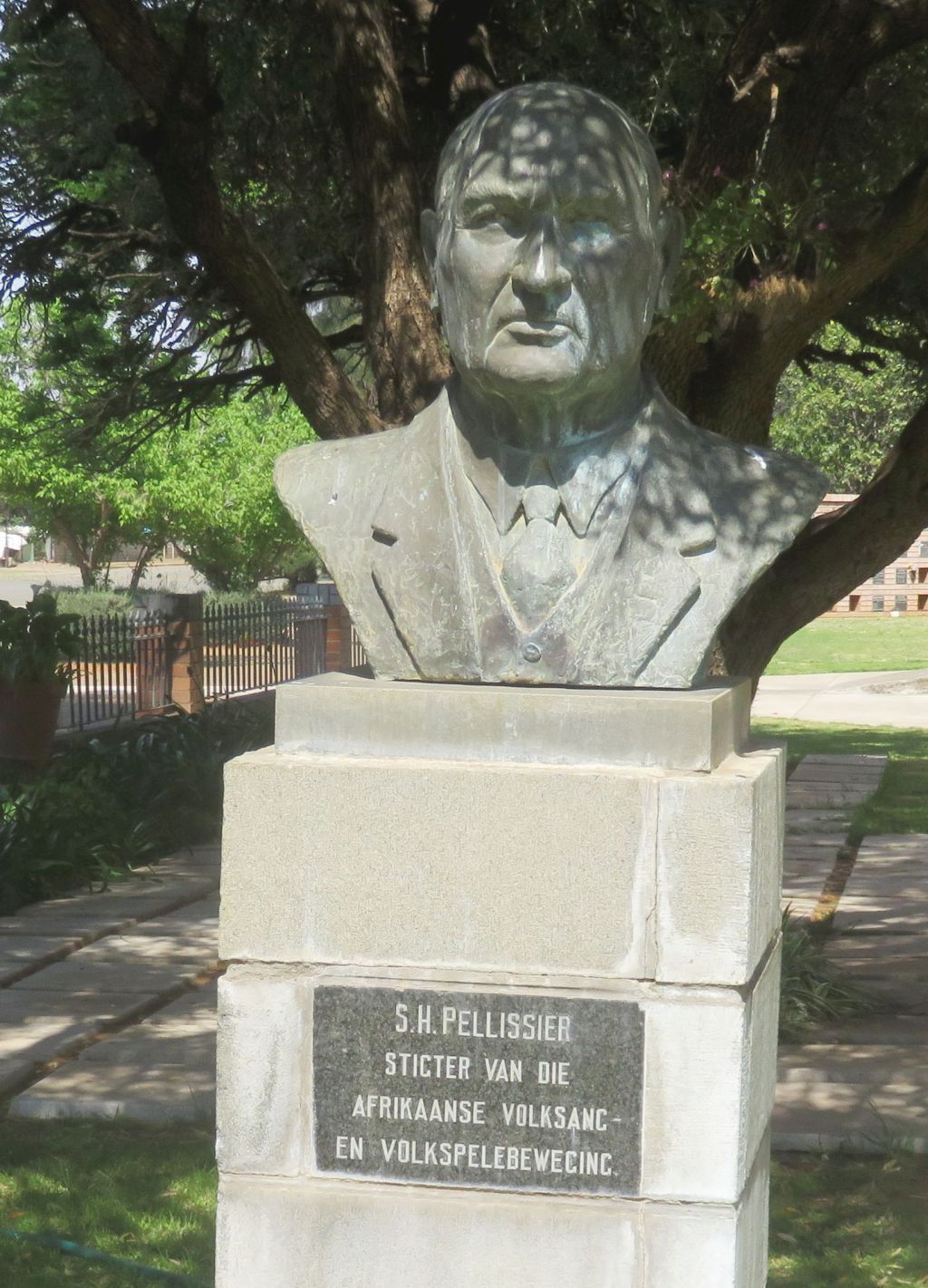 A second bust is that of SH Pellissier, he made his mark here in Boshof because he Started the Volkspeele in this town, 1914. What are volkspeele? I borrowed direct from Wikipedia:
A second bust is that of SH Pellissier, he made his mark here in Boshof because he Started the Volkspeele in this town, 1914. What are volkspeele? I borrowed direct from Wikipedia:
The tradition began when Dr. S.H. Pellisier, a South African, was inspired to create folk-dances after witnessing young people in other countries practice folk-dancing in their national dress. Pellisier translated four Swedish dances and taught them to students at the Afrikaans High School in Boshof.
I 'met' him before when going through Ficksburg, there he was the headmaster of the local high school.
Gereformierde Kerk
 One of the sister churches to the NG. The congregation was established as early as 1871. The church was built in 1882 on two stands,which was a donation from the NG church. There is no information about the architect and/or the builder.
One of the sister churches to the NG. The congregation was established as early as 1871. The church was built in 1882 on two stands,which was a donation from the NG church. There is no information about the architect and/or the builder.
A cornerstone did exist, and still is, but was covered by a layer of decorative bricks added to the building as an outer skin in 1960. At the same time a tower was added and a new bell installed. I don't know what the situation is now regarding membership. The grounds and the building are being maintained, but it doesn't show signs of being well used.
Oldest house
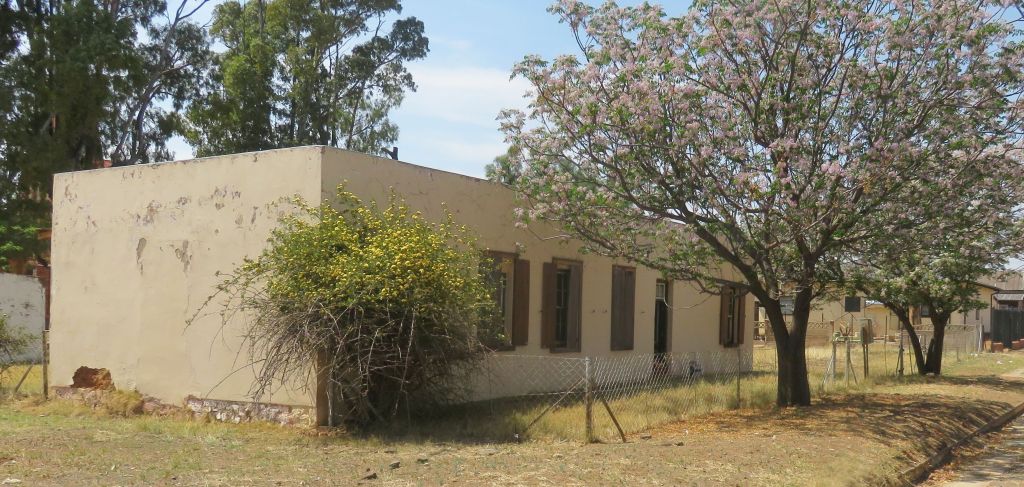 One of the houses which is now nearly 170 years old. It is situated in Jacobs Street and was transferred to Johannes Jacobus Jacobs on 6 March 1857 by the interim Church Council of the community of Boshof. To my knowledge it has been lived in until fairly recently. At the time of our visit (Nov 24) it was being renovated.
One of the houses which is now nearly 170 years old. It is situated in Jacobs Street and was transferred to Johannes Jacobus Jacobs on 6 March 1857 by the interim Church Council of the community of Boshof. To my knowledge it has been lived in until fairly recently. At the time of our visit (Nov 24) it was being renovated.
Jail
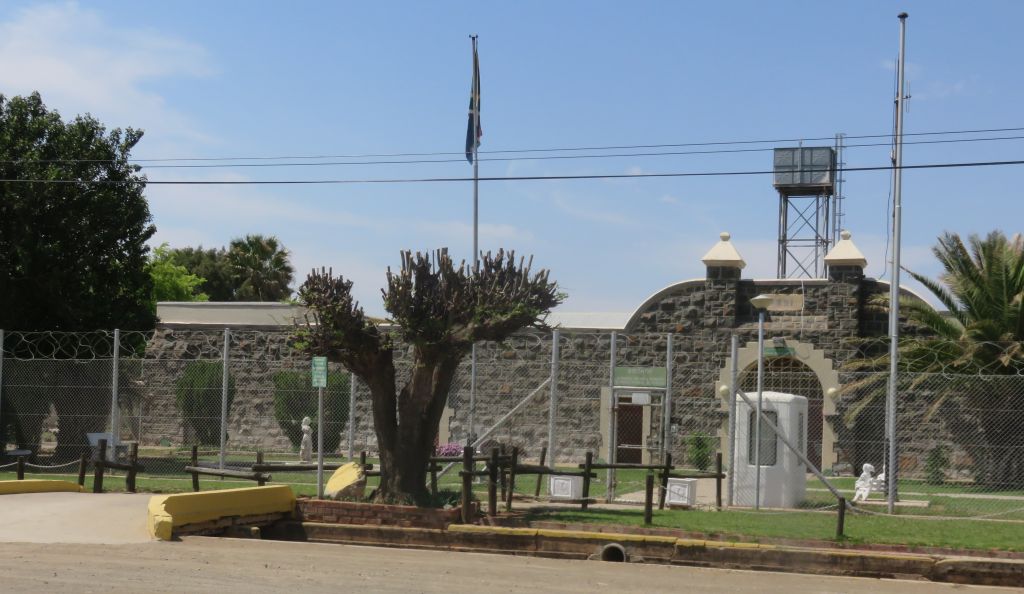
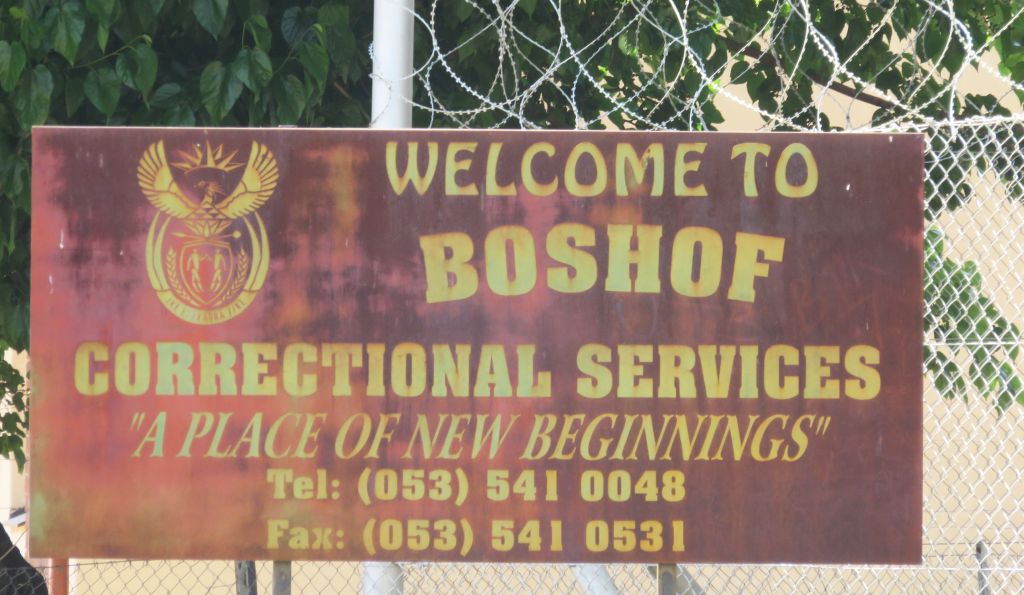 Sorry, not correct, it's the Correctional Services Center. I couldn't find much on its history, but, from the outside, it's a nice building. I don't know how it came about, it was originally designed for Kroonstad, but then built 1891 in Boshof.
Sorry, not correct, it's the Correctional Services Center. I couldn't find much on its history, but, from the outside, it's a nice building. I don't know how it came about, it was originally designed for Kroonstad, but then built 1891 in Boshof.
I like the sign announcing that prisoners are welcome, is it supposed to be sarcasm?
Cemetery
 A big section is the British war graves from the Anglo-Boer war. A surprise find there was the grave of General Comte de Villebois-Mareuil, a French soldier fighting for the Boers. So why would his bones be resting in a British cemetery?
A big section is the British war graves from the Anglo-Boer war. A surprise find there was the grave of General Comte de Villebois-Mareuil, a French soldier fighting for the Boers. So why would his bones be resting in a British cemetery?
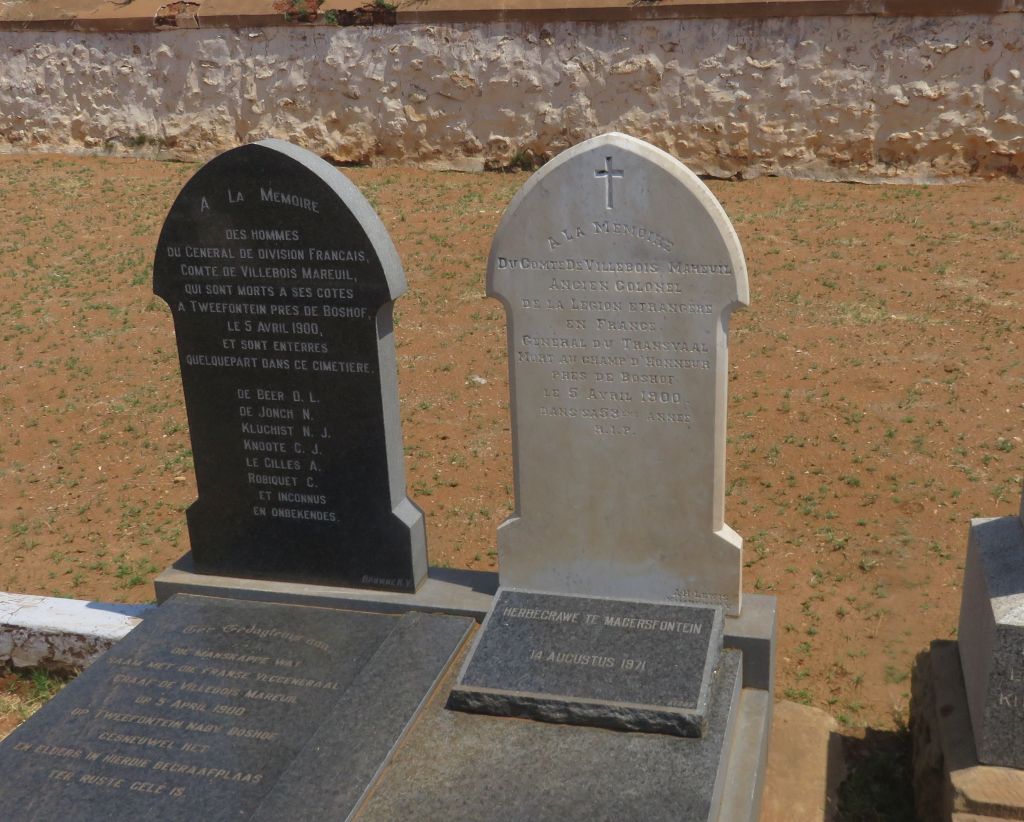 Count Villebois-Mareuil had a military background in France and was one of the foreigners that came to help in the conflict with Britain. He arrived in November 1899 and was appointed a Major in the Boer forces. He distinguished himself in the battle at Colenso in Natal and was promoted to Major-General and was made commander of all foreign volunteers. He was sent west to help defend the Free State.
Near Boshof, 10 km out on the farm Middlekuil, he had an encounter with British forces under Baron Methuan. Heavily outnumbered he held the ground, stubbornly refusing to yield. It cost him his life and that of many of his compatriots.
Count Villebois-Mareuil had a military background in France and was one of the foreigners that came to help in the conflict with Britain. He arrived in November 1899 and was appointed a Major in the Boer forces. He distinguished himself in the battle at Colenso in Natal and was promoted to Major-General and was made commander of all foreign volunteers. He was sent west to help defend the Free State.
Near Boshof, 10 km out on the farm Middlekuil, he had an encounter with British forces under Baron Methuan. Heavily outnumbered he held the ground, stubbornly refusing to yield. It cost him his life and that of many of his compatriots.
His body was taken to Boshof, and given a full military burial by the British, which Methuen paid for out of his own pocket. Two headstones commemorate this event, one for Villeboi and the other for his men. The writing is in French, I got Google to translate. The first headstone reads:
IN MEMORY OF COUNT VILLEBOIS MAREUIL, FORMER COLONEL OF THE FOREIGN LEGION IN FRANCE. GENERAL OF THE TRANSVAAL DIED ON THE FIELD OF HONOUR NEAR
BOSHOF ON APRIL 5, 1900. IN HIS 53RD YEAR. I.P.
The seconds one reads
IN MEMORY OF MEN OF THE FRENCH GENERAL DIVISION, COUNT OF VILLEBOIS MAREUIL, WHO DIED AT HIS SIDE AT TWEEFONTEIN NEAR BOSHOF, ON APRIL 5, 1900, AND ARE BURIED SOMEWHERE IN THIS CEMETERY.
A list of names follows that: De Beer D.L., De Jonch N., Kluchist N.J., Knoote C.J.,le Cillers A., and unknowns.
His body was exhumed and reburied in the Heroes Acre in Magersfontein in 1969.
References
Ref 1.: Standard Encyclopedia of Southern Africa, Nasou Limited, 1974
Ref 2.: "Ons Kerk Album van Hollandsche Kerken en Leeraren", printed by Cape Times, 1917